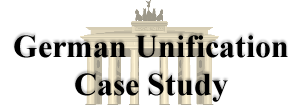
Goals & Issues - Group B
Home
Introduction
Historical Background
The
Discussion
Goals &
Issues
Characters
Teacher's
Guide
Index
Download PDF Evaluation Form
Trouble viewing the evaluation form?
Click here for Adobe PDF reader.
Issues B
This page will provide you with the background to the issues to be resolved by your discussion group. We encourage you to access further information through the provided links.
As you are preparing for the discussion:
a) think of how to present your arguments.
b) anticipate the counter arguments to your position.
c) envision the implication(s) of possible solutions.
Group B: Security Issues
Militarily, East Germany, because of its geographical position and its divided capital of Berlin, had an inordinate amount of soldiers, border guards, and secret police: there were more per capita than in any other East European nation. After unification, a decision has to be reached whether or not border guards and secret police will be punished for their actions which were often illegal under West German law. As for the military, the question is to what extent should they be incorporated into the West German Army and should East Germany be allowed to join the western alliance of NATO (the North Atlantic Treaty Organization)? Here are the particular issues you will need to resolve in your group discussion:
The Military
When the Wall falls and East and West Germany unite, the East German Army (NPA) consists of approximately 175, 000 soldiers. These soldiers are supposed to be "citizens in uniform" by virtue of a conscript Army. However, they are actually in a Germanized version of the Soviet Army, which is very heavy at the top. Political officers, in particular, are paid to ensure that Communist Party morale remains high among the troops. The West German Army, the Bundeswehr, was 500,000 strong prior to 1990. However, it is decided in 1990 that the Bundeswehr will be reduced to 370,000 by 1994. Authorities decide there is room for approximately 23,000 NVA officers in the Bundeswehr, but even this small number is upsetting to West Germans, who are already concerned about their shrinking numbers.
There are problems with using the equipment of the NPA as well as environmental damage created by the NPA. Many aircraft, tanks and small arms cannot be used as there is no guaranteed supply of replacement parts. Former East German and Soviet soldiers are illegally selling this equipment to organized crime syndicates. Meanwhile, commanding officers have been dumping excess fuel so they could claim to have flown the required number of flights.
There is the further problem of NATO membership. Should Germany, now that it does not threaten its eastern neighbors, take part in NATO peacekeeping missions? Should Germany, given its historical role as an aggressor in Europe, avoid participation in any kind of external military operations as many believe is the intent of West Germany's basic law?
Border Guards
The issue of border guards and justice is being raised because border guards were given orders to shoot to kill anyone who was escaping East Berlin or East Germany. In May 1974, the German National Defense Council gave specific orders that firearms be used "with consideration" to stop border crossings. It was unclear whether this meant soldiers may or must shoot, but solders believed they had to shoot. Already in 1961, one soldier who did not shoot was condemned to two years in prison. Also, if soldiers missed their targeted escapee, they were demoted and lost all honors. The situation was clearly a bad one for border guards as 3,000 of them escaped to West Germany over almost four decades.
STASI
Prior to unification, the Stasi (state security forces or secret police) owned 41 buildings, 1,100 safe houses, 300 vacation houses, 100 sports facilities and 18,000 safe houses to meet with spies. They held files on 6 million people. When the roundtable of East German government still existed in March 1990, dissidents did not want people in the West to hurt East Germans, so they destroyed the hard disc of central records. The East German Interior Minister, Diestel, argued that files should remain in East Germany under an independent authority and that victims should own their own dossier. If all the files are stacked upwards, they are 125 miles high. Some East Germans argue that there should be an amnesty because so many files contain false information. Even Chancellor Kohl in his official visit with General Secretary Eric Honecker in 1987 appeared to acknowledge the legitimacy of the East German system. Others, often dissidents, who view themselves as victims of the Stasi, want severe punishment.
In 1992, the German Government sets up an Enquetekommision, which was supposed to accomplish a general Geschichtsaufarbeitung concerning the Stasi and other subjects. Many East Germans viewed this as a colossal waste of money and the classic, the hypocritical West German approach to Siegerjustiz. East Germans, for example, got rid of all but 10 former Nazi judges in the two years after WWII. In 1970, about half of West German judges were Third Reich holdovers.
*Additional off-site links -
Border Guards
*All off-site links will be displayed in new pages
<< Previous
Goals & Issues - Characters - Teacher's Guide - Index

Foothill College, 12345 El Monte Road, Los Altos Hills, CA 94022-4599
News & Info - Apply & Register - Degrees & Programs - Catalog & Schedule - Student Services